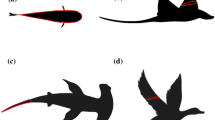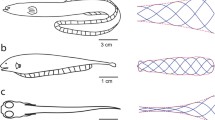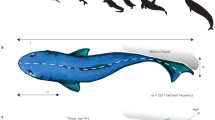Abstract
Recent experimental and computational studies of swimming hydrodynamics have contributed significantly to our understanding of how animals swim, but much remains to be done. Ten questions are presented here as an avenue to discuss some of the arenas in which progress still is needed and as a means of considering the technical approaches to address these questions. 1. What is the three-dimensional structure of propulsive surfaces? 2. How do propulsive surfaces move in three dimensions? 3. What are the hydrodynamic effects of propulsor deformation during locomotion? 4. How are locomotor kinematics and dynamics altered during unsteady conditions? 5. What is the three-dimensional structure of aquatic animal vortex wakes? 6. To what extent are observed propulsor deformations actively controlled? 7. What is the response of the body and fins of moving animals to external perturbations? 8. How can robotic models help us understand locomotor dynamics of organisms? 9. How do propulsive surfaces interact hydrodynamically during natural motions? 10. What new computational approaches are needed to better understand locomotor hydrodynamics? These ten questions point, not exclusively, toward areas in which progress would greatly enhance our understanding of the hydrodynamics of swimming organisms, and in which the application of new technology will allow continued progress toward understanding the interaction between organisms and the aquatic medium in which they live and move.





Similar content being viewed by others
References
Akhtar I, Mittal R, Lauder GV, Drucker E (2007) Hydrodynamics of a biologically inspired tandem flapping foil configuration. Theor Comput Fluid Dyn 21:155–170
Alben S (2008) Optimal flexibility of a flapping appendage in an inviscid fluid. J Fluid Mech 614:355–380
Alben S, Shelley M, Zhang J (2004) How flexibility induces streamlining in a two-dimensional flow. Phys Fluids 16:1694
Alben S, Madden PGA, Lauder GV (2007) The mechanics of active fin-shape control in ray-finned fishes. J Roy Soc Interface 4:243–256
Bainbridge R (1963) Caudal fin and body movements in the propulsion of some fish. J Exp Biol 40:23–56
Bandyopadhyay PR (2002) Maneuvering hydrodynamics of fish and small underwater vehicles. Int Comp Biol 42:102–117
Bartol IK, Gharib M, Webb PW, Weihs D, Gordon MS (2005) Body-induced vortical flows: a common mechanism for self-corrective trimming control in boxfishes. J Exp Biol 208:327–344
Birch JM, Dickinson MH (2003) The influence of wing-wake interactions on the production of aerodynamic forces in flapping flight. J Exp Biol 206:2257–2272
Blondeaux P, Fornarelli F, Guglielmini L, Triantafyllou MS, Verzicco R (2005) Numerical experiments on flapping foils mimicking fish-like locomotion. Phys Fluids 17:113601
Borazjani I, Sotiropoulos F (2008) Numerical investigation of the hydrodynamics of carangiform swimming in the transitional and inertial flow regimes. J Exp Biol 211:1541–1558
Borazjani I, Sotiropoulos F (2009) Numerical investigation of the hydrodynamics of anguilliform swimming in the transitional and inertial flow regimes. J Exp Biol 212:576–592
Bowtell G, Williams TL (1991) Anguilliform body dynamics—modelling the interaction between muscle activation and body curvature. Phil Trans R Soc Lond B 334:385–390
Bowtell G, Williams TL (1994) Anguilliform body dynamics—a continuum model for the interaction between muscle activation and body curvature. J Math Biol 32:83–91
Bozkurttas M, Dong H, Mittal R, Madden P, Lauder GV (2006) Hydrodynamic performance of deformable fish fins and flapping foils. AIAA paper 2006-1392
Bozkurttas M, Mittal R, Dong H, Lauder GV, Madden P (2009) Low-dimensional models and performance scaling of a highly deformable fish pectoral fin. J Fluid Mech 631:311–342
Brücker C, Bleckmann H (2007) Vortex dynamics in the wake of a mechanical fish. Exp Fluids 43:799–810
Carling JC, Williams TL, Bowtell G (1998) Self-propelled anguilliform swimming: simultaneous solution of the two-dimensional Navier–Stokes equations and Newton’s laws of motion. J Exp Biol 201:3143–3166
Collin SP, Marshall NJ (2003) Sensory processing in aquatic environments. Springer Verlag, New York
Coombs SA, Van Netten SM (2006) The hydrodynamics and structural mechanics of the lateral line system. In: Shadwick RE, Lauder GV (eds) Fish biomechanics volume 23 in fish physiology. Academic Press, San Diego, pp 103–139
Cooper LN, Sedano N, Johansson S, May B, Brown JD, Holliday CM, Kot BW, Fish FE (2008) Hydrodynamic performance of the minke whale (Balaenoptera acutorostrata) flipper. J Exp Biol 211:1859–1867
Dabiri JO (2005) On the estimation of swimming and flying forces from wake measurements. J Exp Biol 208:3519–3532
Dabiri JO (2009) Optimal vortex formation as a unifying principle in biological propulsion. Ann Rev Fluid Mech 41:17–33
Dabiri JO, Colin SP, Costello JH, Gharib M (2005) Flow patterns generated by oblate medusan jellyfish: field measurements and laboratory analyses. J Exp Biol 208:1257–1265
Dabiri JO, Colin SP, Costello JH (2006) Fast-swimming hydromedusae exploit velar kinematics to form an optimal vortex wake. J Exp Biol 209:2025–2033
Drucker EG, Lauder GV (1999) Locomotor forces on a swimming fish: three-dimensional vortex wake dynamics quantified using digital particle image velocimetry. J Exp Biol 202:2393–2412
Drucker EG, Lauder GV (2000) A hydrodynamic analysis of fish swimming speed: wake structure and locomotor force in slow and fast labriform swimmers. J Exp Biol 203:2379–2393
Drucker EG, Lauder GV (2001) Locomotor function of the dorsal fin in teleost fishes: experimental analysis of wake forces in sunfish. J Exp Biol 204:2943–2958
Dubois AB, Ogilvy CS (1978) Forces on the tail surface of swimming fish: thrust, drag and acceleration in bluefish (Pomatomus saltatrix). J Exp Biol 77:225–241
DuBois AB, Cavagna GA, Fox RS (1976) Locomotion of bluefish. J Exp Zool 195:223–235
Epps B, Techet A (2007) Impulse generated during unsteady maneuvering of swimming fish. Exp Fluids 43:691–700
Fish F (2004) Structure and mechanics of nonpiscine control surfaces. IEEE J Oceanic Eng 29:605–621
Fish F, Lauder GV (2006) Passive and active flow control by swimming fishes and mammals. Ann Rev Fluid Mech 38:193–224
Fish FE, Howle LE, Murray MM (2008) Hydrodynamic flow control in marine mammals. Integr Comp Biol 48:788–800
Flammang BE, Lauder GV (2008) Speed-dependent intrinsic caudal fin muscle recruitment during steady swimming in bluegill sunfish, Lepomis macrochirus. J Exp Biol 211:587–598
Flammang BE, Lauder GV (2009) Caudal fin shape modulation and control during acceleration, braking and backing maneuvers in bluegill sunfish, Lepomis macrochirus. J Exp Biol 212:277–286
Fontaine EI, Zabala F, Dickinson MH, Burdick JW (2009) Wing and body motion during flight initiation in Drosophila revealed by automated visual tracking. J Exp Biol 212:1307–1323
Geerlink PJ, Videler JJ (1987) The relation between structure and bending properties of teleost fin rays. Neth J Zool 37:59–80
Hain R, Kähler C, Michaelis D (2008) Tomographic and time resolved PIV measurements on a finite cylinder mounted on a flat plate. Exp Fluids 45:715–724
Hertel H (1966) Structure, form and movement. Reinhold, New York, NY
Hoerner SF (1965) Fluid-dynamic drag. Hoerner Fluid Dynamics, Bakersfield, California
Horner AM, Jayne BC (2008) The effects of viscosity on the axial motor pattern and kinematics of the African lungfish (Protopterus annectens) during lateral undulatory swimming. J Exp Biol 211:1612–1622
Hunt von Herbing I, Keating K (2003) Temperature-induced changes in viscosity and its effects on swimming speed in larval haddock. In: Browman HI, Skiftesvik A (eds) The big fish bang. Institute of Marine Research, Bergen, pp 23–34
Johnson TP, Cullum AJ, Bennett AF (1998) Partitioning the effects of temperature and kinematic viscosity on the c-start performance of adult fishes. J Exp Biol 201:2045–2051
Kato N (2000) Control performance in the horizontal plane of a fish robot with mechanical pectoral fins. IEEE J Oceanic Eng 25:121–129
Lauder GV (1989) Caudal fin locomotion in ray-finned fishes: historical and functional analyses. Amer Zool 29:85–102
Lauder GV (2000) Function of the caudal fin during locomotion in fishes: kinematics, flow visualization, and evolutionary patterns. Amer Zool 40:101–122
Lauder GV (2006) Locomotion. In: Evans DH, Claiborne JB (eds) The physiology of fishes, 3rd edn. CRC Press, Boca Raton, pp 3–46
Lauder GV, Drucker EG (2002) Forces, fishes, and fluids: hydrodynamic mechanisms of aquatic locomotion. News Physiol Sci 17:235–240
Lauder GV, Madden PGA (2006) Learning from fish: kinematics and experimental hydrodynamics for roboticists. Int J Automat Comput 4:325–335
Lauder GV, Madden PGA (2007) Fish locomotion: kinematics and hydrodynamics of flexible foil-like fins. Exp Fluids 43:641–653
Lauder GV, Madden PGA (2008) Advances in comparative physiology from high-speed imaging of animal and fluid motion. Ann Rev Physiol 70:143–163
Lauder GV, Tytell ED (2006) Hydrodynamics of undulatory propulsion. In: Shadwick RE, Lauder GV (eds) Fish biomechanics volume 23 in fish physiology. Academic Press, San Diego, pp 425–468
Lauder GV, Madden PGA, Mittal R, Dong H, Bozkurttas M (2006) Locomotion with flexible propulsors I: experimental analysis of pectoral fin swimming in sunfish. Bioinsp Biomimet 1:S25–S34
Lauder GV, Anderson EJ, Tangorra J, Madden PGA (2007) Fish biorobotics: kinematics and hydrodynamics of self-propulsion. J Exp Biol 210:2767–2780
Lehmann F-O (2008) When wings touch wakes: understanding locomotor force control by wake wing interference in insect wings. J Exp Biol 211:224–233
Lehmann F-O (2009) Wing–wake interaction reduces power consumption in insect tandem wings. Exp Fluids 46:765–775
Lehmann F-O, Sane SP, Dickinson M (2005) The aerodynamic effects of wing-wing interaction in flapping insect wings. J Exp Biol 208:3075–3092
Liao J (2004) Neuromuscular control of trout swimming in a vortex street: implications for energy economy during the Karman gait. J Exp Biol 207:3495–3506
Liao J, Beal DN, Lauder GV, Triantafyllou MS (2003a) Fish exploiting vortices decrease muscle activity. Science 302:1566–1569
Liao J, Beal DN, Lauder GV, Triantafyllou MS (2003b) The Kármán gait: novel body kinematics of rainbow trout swimming in a vortex street. J Exp Biol 206:1059–1073
Liu H, Wassersug RJ, Kawachi K (1997) The three-dimensional hydrodynamics of tadpole locomotion. J Exp Biol 200:2807–2819
Long J (1998) Muscles, elastic energy, and the dynamics of body stiffness in swimming eels. Amer Zool 38:771–792
Long JH, Nipper KS (1996) The importance of body stiffness in undulatory propulsion. Amer Zool 36:678–694
Long JH Jr, Koob TJ, Irving K, Combie K, Engel V, Livingston N, Lammert A, Schumacher J (2006) Biomimetic evolutionary analysis: testing the adaptive value of vertebrate tail stiffness in autonomous swimming robots. J Exp Biol 209:4732–4746
Mittal R, Dong H, Bozkurttas M, Lauder GV, Madden PGA (2006) Locomotion with flexible propulsors II: computational modeling and analysis of pectoral fin swimming in sunfish. Bioinsp Biomimet 1:S35–S41
Müller UK, Smit J, Stamhuis EJ, Videler JJ (2001) How the body contributes to the wake in undulatory fish swimming: flow fields of a swimming eel (Anguilla anguilla). J Exp Biol 204:2751–2762
Nauen JC, Lauder GV (2002a) Hydrodynamics of caudal fin locomotion by chub mackerel, Scomber japonicus (Scombridae). J Exp Biol 205:1709–1724
Nauen JC, Lauder GV (2002b) Quantification of the wake of rainbow trout (Oncorhynchus mykiss) using three-dimensional stereoscopic digital particle image velocimetry. J Exp Biol 205:3271–3279
Peng J, Dabiri JO (2008a) An overview of a Lagrangian method for analysis of animal wake dynamics. J Exp Biol 211:280–287
Peng J, Dabiri JO (2008b) The ‘upstream wake’ of swimming and flying animals and its correlation with propulsive efficiency. J Exp Biol 211:2669–2677
Pereira F, Gharib M, Dabiri D, Modarress D (2000) Defocusing digital particle image velocimetry: a 3-component 3-dimensional DPIV measurement technique. Application to bubbly flows. Exp Fluids 29:S78–S84
Ramamurti R, Sandberg WC, Lohner R, Walker JA, Westneat M (2002) Fluid dynamics of flapping aquatic flight in the bird wrasse: three-dimensional unsteady computations with fin deformation. J Exp Biol 205:2997–3008
Sakakibara J, Nakagawa M, Yoshida M (2004) Stereo-PIV study of flow around a maneuvering fish. Exp Fluids 36:282–293
Shadwick RE, Lauder GV (2006) Fish biomechanics. In: Hoar WS, Randall DJ, Farrell AP (eds) Fish physiology, vol 23. Academic Press, San Diego
Shen L, Zhang X, Yue D, Triantafyllou MS (2003) Turbulent flow over a flexible wall undergoing a streamwise travelling wave motion. J Fluid Mech 484:197–221
Shirgaonkar AA, Curet OM, Patankar NA, MacIver MA (2008) The hydrodynamics of ribbon-fin propulsion during impulsive motion. J Exp Biol 211:3490–3503
Shoele K, Zhu Q (2009) Fluid–structure interactions of skeleton-reinforced fins: performance analysis of a paired fin in lift-based propulsion. J Exp Biol 212:2679–2690
Standen EM (2008) Pelvic fin locomotor function in fishes: three-dimensional kinematics in rainbow trout (Oncorhynchus mykiss). J Exp Biol 211:2931–2942
Standen EM, Lauder GV (2005) Dorsal and anal fin function in bluegill sunfish (Lepomis macrochirus): three-dimensional kinematics during propulsion and maneuvering. J Exp Biol 205:2753–2763
Standen EM, Lauder GV (2007) Hydrodynamic function of dorsal and anal fins in brook trout (Salvelinus fontinalis). J Exp Biol 210:325–339
Svizher A, Cohen J (2006) Holographic particle image velocimetry measurements of hairpin vortices in a subcritical air channel flow. Phys Fluids 18:014105–014114
Taft N, Lauder GV, Madden PG (2008) Functional regionalization of the pectoral fin of the benthic longhorn sculpin during station holding and swimming. J Zool Lond 276:159–167
Tan G-K, Shen G-X, Huang S-Q, Su W–H, Ke Y (2007) Investigation of flow mechanism of a robotic fish swimming by using flow visualization synchronized with hydrodynamic force measurement. Exp Fluids 43:811–821
Tangorra J, Anquetil P, Fofonoff T, Chen A, Del Zio M, Hunter I (2007) The application of conducting polymers to a biorobotic fin propulsor. Bioinsp Biomimet 2:S6–S17
Triantafyllou MS, Triantafyllou GS (1995) An efficient swimming machine. Sci Amer 272:64–70
Triantafyllou MS, Triantafyllou GS, Yue DKP (2000) Hydrodynamics of fishlike swimming. Ann Rev Fluid Mech 32:33–53
Triantafyllou M, Hover FS, Techet AH, Yue D (2005) Review of hydrodynamic scaling laws in aquatic locomotion and fish swimming. Transactions of the ASME 58:226–237
Troolin D, Longmire E (2008) Volumetric 3-component velocity measurements of vortex rings from inclined exits. In: 14th international symposium on applications of laser techniques to fluid mechanics. Lisbon, Portugal, pp 1–11
Tytell ED (2004) Kinematics and hydrodynamics of linear acceleration in eels, Anguilla rostrata. Proc Roy Soc Lond B 271:2535–2540
Tytell ED (2006) Median fin function in bluegill sunfish, Lepomis macrochirus: streamwise vortex structure during steady swimming. J Exp Biol 209:1516–1534
Tytell ED, Lauder GV (2004) The hydrodynamics of eel swimming. I. Wake structure. J Exp Biol 207:1825–1841
Tytell ED, Lauder GV (2008) Hydrodynamics of the escape response in bluegill sunfish, Lepomis macrochirus. J Exp Biol 211:3359–3369
Tytell ED, Standen EM, Lauder GV (2008) Escaping flatland: three-dimensional kinematics and hydrodynamics of median fins in fishes. J Exp Biol 211:187–195
Usherwood JR, Lehman F-O (2008) Phasing of dragonfly wings can improve aerodynamic efficiency by removing swirl. J Roy Soc Interface 5:1303–1307
Videler JJ (1993) Fish swimming. Chapman and Hall, New York
Wakeling JM (2006) Fast-start mechanics. In: Shadwick RE, Lauder GV (eds) Fish biomechanics volume 23 in fish physiology. Academic Press, San Diego, pp 333–368
Wang H, Ando N, Kanzaki R (2008) Active control of free flight manoeuvres in a hawkmoth, Agrius convolvuli. J Exp Biol 211:423–432
Webb PW (1975) Hydrodynamics and energetics of fish propulsion. Bull Fish Res Bd Can 190:1–159
Webb PW (2004a) Maneuverability–general issues. IEEE J Oceanic Eng 29:547–555
Webb PW (2004b) Response latencies to postural disturbances in three species of teleostean fishes. J Exp Biol 207:955–961
Webb P (2006) Stability and maneuverability. In: Shadwick RE, Lauder GV (eds) Fish biomechanics volume 23 in fish physiology. Academic Press, San Diego, pp 281–332
Webb JF, Fay RR, Popper A (2008) Fish bioacoustics. Springer Verlag, New York
Weber PW, Howle LE, Murray MM, Fish FE (2009) Lift and drag performance of odontocete cetacean flippers. J Exp Biol 212:2149–2158
Wieneke B (2008) Volume self-calibration for 3D particle image velocimetry. Exp Fluids 45:549–556
Wilga CD, Lauder GV (2004) Hydrodynamic function of the shark’s tail. Nature 430:850
Willert C (1997) Stereoscopic digital particle image velocimetry for application in wind tunnel flows. Meas Sci Technol 8:1465–1479
Wolfgang MJ, Anderson JM, Grosenbaugh M, Yue D, Triantafyllou M (1999) Near-body flow dynamics in swimming fish. J Exp Biol 202:2303–2327
Zhang W, Hain R, Kähler C (2008) Scanning PIV investigation of the laminar separation bubble on a SD7003 airfoil. Exp Fluids 45:725–743
Zhu Q, Shoele K (2008) Propulsion performance of a skeleton-strengthened fin. J Exp Biol 211:2087–2100
Zhu Q, Wolfgang MJ, Yue DKP, Triantafyllou GS (2002) Three-dimensional flow structures and vorticity control in fish-like swimming. J Fluid Mech 468:1–28
Acknowledgments
This work was supported by an ONR-MURI Grant N00014-03-1-0897, and by ONR grant N00014-09-1-0352. We thank Drs. Rajat Mittal for many helpful discussions on bio-inspired propulsion. Many thanks to members of the Lauder and Tangorra Laboratories for numerous helpful discussions, and to Timo Gericke for constructing the vortex generator.
Author information
Authors and Affiliations
Corresponding author
Rights and permissions
About this article
Cite this article
Lauder, G.V. Swimming hydrodynamics: ten questions and the technical approaches needed to resolve them. Exp Fluids 51, 23–35 (2011). https://doi.org/10.1007/s00348-009-0765-8
Received:
Revised:
Accepted:
Published:
Issue Date:
DOI: https://doi.org/10.1007/s00348-009-0765-8




